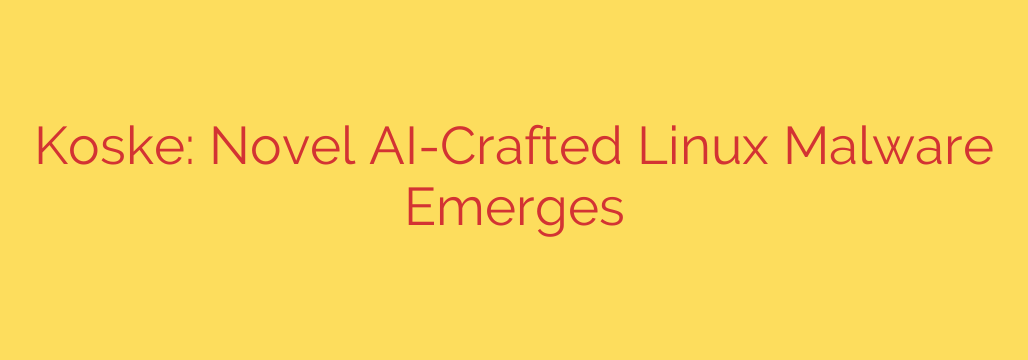
AI-Crafted Malware ‘Koske’ Emerges: A New Threat to Linux Security
The intersection of artificial intelligence and cybercrime is no longer a futuristic concept—it’s a present-day reality. A new, sophisticated malware variant named Koske has been identified, marking a significant evolution in digital threats. What sets Koske apart is its method of creation: it is believed to be one of the first prominent malware families crafted with the assistance of large language models (LLMs), specifically targeting Linux-based systems.
This development signals a new era where attackers are leveraging AI to automate and enhance their malicious code, making it more evasive, complex, and dangerous than ever before.
Understanding Koske: A New Breed of Linux Malware
At its core, Koske is designed to infiltrate systems running the Linux operating system. This is a critical concern, as Linux powers a vast majority of the world’s servers, cloud infrastructure, and Internet of Things (IoT) devices. A successful attack on these systems can lead to massive data breaches, service disruptions, and widespread security compromises.
The true innovation behind Koske lies in its AI-assisted development. By using AI, cybercriminals can:
- Generate Polymorphic Code: The malware can automatically rewrite its own code for each new infection. This creates nearly infinite unique versions, making it extremely difficult for traditional signature-based antivirus software to detect. Each instance looks different, slipping past defenses that search for a known digital fingerprint.
- Lower the Barrier to Entry: Creating sophisticated malware typically requires deep expertise. However, with AI tools, less-skilled attackers can generate complex and functional malicious code by simply providing high-level instructions.
- Enhance Evasion Techniques: AI can be used to write code that is intentionally obfuscated and complex, designed to confuse security analysts and automated defense systems.
How AI Gives Koske an Edge
The use of AI in Koske’s creation is not just a gimmick; it provides tangible advantages to attackers. The primary threat comes from its ability to adapt and hide. While traditional malware might use a single method to communicate with its command-and-control (C2) server, an AI-generated variant like Koske could be programmed to test multiple communication protocols and encryption methods, settling on whichever is least likely to be monitored or blocked.
This adaptive nature means that defenses must shift from looking for what is known to be bad to identifying unusual behavior. Detecting AI-crafted malware requires a focus on behavioral analysis—flagging anomalous processes, unexpected network traffic, or unauthorized file access, rather than just matching a known malware signature.
Who Should Be on High Alert?
Given its focus on Linux, the emergence of Koske is a direct threat to a wide range of critical infrastructure and business operations. Key targets include:
- Cloud Service Providers and Their Customers: The backbone of the modern internet runs on Linux servers in the cloud.
- Corporate Data Centers: On-premise servers handling sensitive company data are prime targets.
- IoT and Embedded Systems: From smart city infrastructure to industrial control systems, countless connected devices run on stripped-down Linux versions.
A compromise in any of these areas can have cascading effects, impacting not just one organization but potentially millions of users who rely on their services.
Actionable Steps to Protect Against AI-Driven Malware
Defending against an evolving threat like Koske requires a modern, proactive security posture. Relying solely on outdated methods is no longer sufficient. Here are crucial steps to enhance your defenses:
- Embrace Behavior-Based Detection: Move beyond signature-based tools. Invest in Endpoint Detection and Response (EDR) and Extended Detection and Response (XDR) solutions that monitor system behavior in real-time. Anomalous activity is the new red flag.
- Implement a Zero-Trust Architecture: Operate under the principle of “never trust, always verify.” Strictly control access, enforce multi-factor authentication (MFA), and ensure every user and device is authenticated before accessing resources.
- Maintain Rigorous Patch Management: While Koske is sophisticated, many infections still begin by exploiting known vulnerabilities. Keeping your operating system, kernel, and all software fully patched is a fundamental and non-negotiable security practice.
- Strengthen Network Segmentation: Isolate critical systems from the rest of the network. This contains the blast radius of a potential infection, preventing malware from moving laterally to compromise your entire infrastructure.
- Conduct Continuous Monitoring and Logging: Comprehensive logging of system and network activity is essential for forensic analysis. If a breach does occur, these logs will be invaluable for understanding the attack and preventing a recurrence.
The Future of Cybersecurity in an AI World
Koske is more than just another piece of malware; it’s a proof of concept for the future of cyber warfare. It demonstrates that the same AI technologies driving innovation in business can be weaponized with devastating effect. As AI tools become more powerful and accessible, we must anticipate an increase in sophisticated, evasive, and automated threats.
The security community must adapt by fighting fire with fire—using AI and machine learning to power next-generation defense systems that can detect and respond to threats at machine speed. For now, vigilance, proactive defense, and a commitment to modern security principles remain our best defense against this emerging challenge.
Source: https://securityaffairs.com/180355/malware/koske-a-new-ai-generated-linux-malware-appears-in-the-threat-landscape.html








